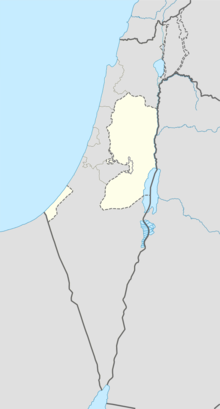
Back قبر النبي صموئيل Arabic Národní park Nebi Samu'el Czech Tumba de Samuel Spanish נבי סמואל HE Park Narodowy Nabi Samuil Polish சாமுவேலின் கல்லறை Tamil Samuel'in Kabri Turkish مقبرہ سموئیل Urdu
 Nabi Samwil mosque built on remains of Crusader-era fortress; the Tomb of Samuel is in a crypt below the Mamluk building. | |
| Coordinates | 31°49′59″N 35°10′54″E / 31.832978°N 35.181633°E |
|---|---|

The Tomb of Samuel (Arabic: النبي صموئيل, translit. an-Nabi Samu'il or Nebi Samwil, Hebrew: קבר שמואל הנביא, translit. Kever Shmuel ha-Navi), commonly known as Nebi Samuel or Nebi Samwil, is the traditional burial site of the biblical prophet Samuel, atop a steep hill at an elevation of 908 m (2,979 ft) above sea level, in the Palestinian village of Nabi Samwil, in the West Bank.[1]
The site is of both religious and archaeological interest. In the 6th century, a monastery was built at the site in honor of Samuel, and during the early Arab period the place was known as Dir Samwil (the Samuel Monastery).[2] In the 12th century, during the Crusader period, a fortress was built on the area.[2]
The present structure is a mosque from the 14th century, built during the Mamluk period.[2] The purported tomb itself is in an underground chamber which has been repurposed after 1967 as a synagogue, today with separate prayer areas for Jewish men and women.
Since the beginning of the Israeli occupation of the West Bank after the Six-Day War, the site is managed by the Israel Nature and Parks Authority.
- ^ "Hanukkah menorah removed from roof of mosque after Palestinians protest". www.timesofisrael.com. 25 November 2021. Retrieved 29 July 2022.
- ^ a b c "Nebi Samuel Park – Israel Nature and Parks Authority". en.parks.org.il. Archived from the original on 2022-03-12. Retrieved 2022-06-03.
© MMXXIII Rich X Search. We shall prevail. All rights reserved. Rich X Search
